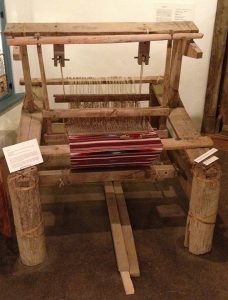As part of my visit to the Millicent Rogers Museum (MRM) I wandered through the galleries, looking for exhibits that included artifacts similar to our collections at the Luther Bean Museum and specifically textiles. One gallery included both Rio Grande and Navajo textiles and also a small scale Navajo upright loom. Another gallery included a European horizontal loom and Rio Grande textiles. A loom holds warp threads in tension so that weft yarns may be woven through them. Textiles woven on these two looms have differing characteristics.

Navajo upright loom at the Millicent Rogers Museum
Navajo upright (vertical) looms have no moving parts and can be quite wide because the warp threads are strung on a horizontal pole that is mounted between two upright support poles or even between two trees. The loom can easily be taken apart and moved.

At the MRM, Navajo Chief blankets behind the loom
The weaver sits, weaving the weft yarns from bottom to top through the vertical warps. The weaver then moves over and weaves the next area, using a tapestry stitch to weave the new weft yarns adjacent to the last area woven. The tapestry stitch results in what are known as “lazy lines” within the textile, as sections of textile are woven adjacent to each other to make the entire width of the textile.
As seen in the Chief blankets behind the loom in the image to the right, Navajo textiles typically have the warps running in the short dimension and the wefts running in the long dimension.

European style horizontal loom, circa 1800, at the Millicent Rogers Museum
Early European style horizontal looms were set into massive frames of hewn timbers, probably to accommodate the vibration and movement of the harnesses during weaving, and they are not easily moved. These looms are of a fixed width and produce fairly narrow textiles. The textile can be made wider by using one of two techniques, double width or two widths seamed together (as discussed in the Rio Grande Textiles Weaving Details blog entry). The textiles can be quite long, because the warps can be wound around the warp beam and unfurled as the weaving continues to grow in length. The weaver sits or stands at the loom and continues to weave in the same position for the entire textile length, as the woven portion of the textile winds around the take-up beam.

European style horizontal loom, circa 1800, at the Millicent Rogers Museum
These looms often have treadles (foot pedals) on which the weaver steps to raise a portion of the warp threads, called shedding (usually every other warp thread). The weaver then passes the shuttle (which holds the weft yarn) horizontally through the shed from end to end. Textiles woven on European style looms typically have the warps running in the long dimension and the wefts running in the short dimension.
